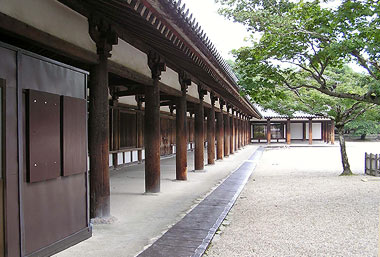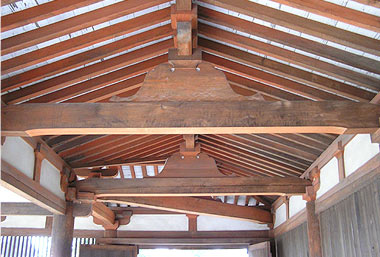|
||
 |
||


Houryuuji 法隆寺 (Nara)
(C)2001 Japanese Architecture and Art Net Users System. No reproduction or republication without written permission.
掲載のテキスト・写真・イラストなど、全てのコンテンツの無断複製・転載を禁じます。
|
||||||
| kairou 回廊 | ||||||
| KEY WORD : architecture / buildings & structures | ||||||
| Also written 廻廊; also called bu 廡, sourou 走廊 or *horou 歩廊. Single-bay corridors are aiso called *tanrou 単廊. A long, narrow, roofed, semi-enclosed corridor one bay wide originally constructed to surround the most sacred precinct containing the *kondou 金堂 and pagoda in 7c-12c Buddhist temples. The outer side is enclosed. Window openings filled with vertical, square lattice is set at an angle, which allows air to flow through. The inner side is open. At Houryuuji 法隆寺, partially rebuilt by the end of the 7c, Kairou is attached to both sides of the middle gate *Chuumon 中門 and now ends where it is joined to each side of the lecture hall *Daikoudou 大講堂. The Kairou encloses the image hall Kondou and the five-storied pagoda *Gojuu-no-tou 五重塔. However, at the Yamadadera 山田寺 site in Nara, the earliest remains unearthed, are sections of a kairou that came to light through excavations from 1982 through 1983. The temple was constructed in the middle of the 7c. From the structural members that could easily be identified, it was possible to produce accurate drawings of the original kairou. Double-bay corridors *fukurou 複廊 are known to have been constructed at Koufukuji 興福寺, Daianji 大安寺, Saidaiji 西大寺, Toudaiji 東大寺 and some Kokubunji 国分寺. The double corridors were divided by partitions into two parallel passageways. The center wall had vertical-muntin windows set between the pillars that supported the ridge *munagi 棟木. Some connecting passageways were covered with a roof, and called konrou 近廊. If an open roofed corridor connected the image hall with the main building it was called *konrou 軒廊. Kairou also came to used at Shinto shrines and at aristocrats' residences *shinden-zukuri 寝殿造. |
||||||
  Houryuuji 法隆寺 (Nara)
|
||||||
| REFERENCES: | ||||||
| *garan haichi 伽藍配置 | ||||||
| EXTERNAL LINKS: | ||||||
| NOTES: | ||||||
(C)2001 Japanese Architecture and Art Net Users System. No reproduction or republication without written permission. 掲載のテキスト・写真・イラストなど、全てのコンテンツの無断複製・転載を禁じます。 |
||||||